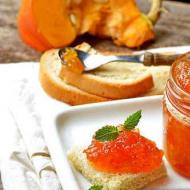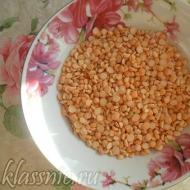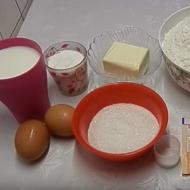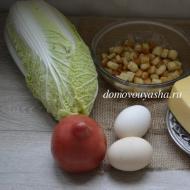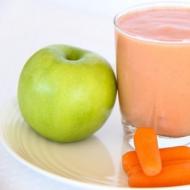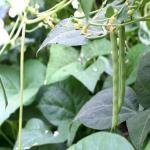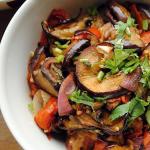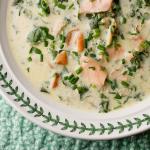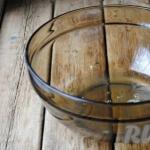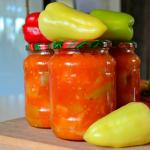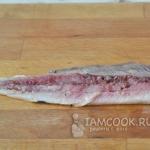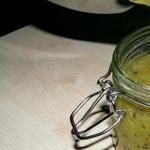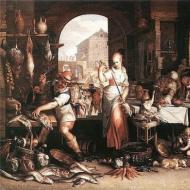
How to properly cook pork feet. Pork leg baked in the oven. Pork knuckles Lyonnaise style
Usually pork hoof is used to cook jellied meat. Although a variety of pork leg dishes are very popular in almost all cuisines of the world. I suggest you find out how to deliciously cook baked pork hoof in the oven.
Recipe contents:
When coming to the supermarket to buy groceries, most housewives completely ignore pork hooves, believing that apart from jellied meat it is impossible to prepare anything tasty and original from them. But this is absolutely in vain! Baked pork legs in the oven is one of the favorite Spanish dishes, which is found at Spanish carnivals, in taverns and bars. Despite the fact that there is very little meat in them, they are quite soft, juicy and satisfying. And although pork hooves take longer to cook than pork ribs, they can quite diversify the everyday menu, and it’s not even a shame to put them on the holiday table.
Baked pork hooves turn out to be very tasty, nutritious and high in calories. Preparing them is not difficult at all. And if you pre-marinate them in various tasty sauces, the dish will turn out no less tasty, but also healthy. I serve it with vegetables, sauces, herbs or with a glass of foamy fresh beer.
A few tips that will tell you how to cook pork legs deliciously.
- Choose pig hooves that are clean, well washed and free of bristles.
- The skin should be undamaged, smooth, with a color ranging from white to slightly pinkish or yellow.
- Dark spots, bluish or gray tint on the skin - the legs are not fresh.
- Do not purchase hooves if the cut is weathered or dried out.
- Press your finger into the fleshy part of the hoof: the resulting hole will immediately straighten out, and will remain for a long time on the damaged leg.
- Fresh hooves with a sweetish aroma.
- Calorie content per 100 g - 216 kcal.
- Number of servings - 1 hoof
- Cooking time - 1.5 hours baking, 30 minutes prep work, plus soaking time
 Ingredients:
Ingredients:
- Pork hoof - 1 pc.
- Salt - 0.5 tsp. or to taste
- Garlic - 2-3 cloves
- Bay leaf - 2 leaves
- Allspice peas - 4 peas
- Soy sauce - 1 tsp.
- Mayonnaise - 1 tbsp.
- Ground black pepper - a pinch
Step-by-step preparation of baked pork hoof:

1. Rinse the pork hoof under running water, scrape it with a knife or wire brush and rinse again. Place the leg in a bowl of water and leave for several hours, or preferably overnight. Rinse soaked hooves and dry with a paper towel. During this time, they will become well limp, and if there is any dirt left on them, it will all come out.
Take a piece of food foil and place your hoof on it. Mix mayonnaise, soy sauce, salt, ground pepper. Also add chopped bay leaf and peppercorns to the sauce. This can be done using a kitchen mill or mortar.

2. You can also season the hoof with any spices and herbs to your taste.

3. Wrap the hoof tightly in foil to ensure there are no empty spaces. It's better to wrap it in several layers of paper. Then the juice and melted fat will not flow out, but will additionally soak the meat.
Serve the finished pork leg immediately after cooking. It is consumed hot. Then it will have a softer taste and delicate aroma.
When going to the grocery store, most housewives completely ignore pork legs, believing that nothing tasty and original, with the exception of jellied meat, can be prepared from them. And absolutely in vain! Despite the fact that cooking pork legs takes longer than cooking, for example, pork ribs or knuckles, the variety of dishes made from pork legs and their taste make them a welcome guest on both our everyday menu and the holiday table. Today we invite you to learn and remember with us how to cook pork legs.
 Today, in our kitchens, dishes made from pork legs are unfairly forgotten, but just recently our grandmothers knew how to prepare delicious snacks and delicious hot dishes from the legs. Even today, pork leg dishes are widely represented in many culinary traditions around the world. Just remember the well-known traditional dish of German cuisine, Eisbahn - pork legs baked with stewed sauerkraut and spicy hunting sausages. Italian Zampone - pork legs stuffed with minced meat with aromatic spices and herbs - are also highly valued by gourmets. The traditional snack Krubins is still popular in Irish bars today - boiled and then pickled or stewed pork legs. In Korean cuisine, pork legs are represented by the dish Partyogi - the legs are boiled with vegetables, herbs and spices and served hot or cold. Pork legs have not been forgotten in traditional Russian cuisine. Jellied meats and jellies were prepared from them, the legs were boiled and baked, fried and stewed.
Today, in our kitchens, dishes made from pork legs are unfairly forgotten, but just recently our grandmothers knew how to prepare delicious snacks and delicious hot dishes from the legs. Even today, pork leg dishes are widely represented in many culinary traditions around the world. Just remember the well-known traditional dish of German cuisine, Eisbahn - pork legs baked with stewed sauerkraut and spicy hunting sausages. Italian Zampone - pork legs stuffed with minced meat with aromatic spices and herbs - are also highly valued by gourmets. The traditional snack Krubins is still popular in Irish bars today - boiled and then pickled or stewed pork legs. In Korean cuisine, pork legs are represented by the dish Partyogi - the legs are boiled with vegetables, herbs and spices and served hot or cold. Pork legs have not been forgotten in traditional Russian cuisine. Jellied meats and jellies were prepared from them, the legs were boiled and baked, fried and stewed.
Of course, at first glance, preparing dishes from pork feet may seem unreasonably time consuming. But only at first glance. Once you prepare delicious stewed, stuffed or baked pork legs, you will be surprised at how tasty and aromatic they turn out, and the pleasure and gratitude of your loved ones will be the most pleasant reward for your work.
Today, the Culinary Eden website has collected and recorded for you the most important secrets and tips, along with proven recipes for original dishes that will easily help even the most inexperienced housewives and tell you how to cook pork legs.
 1. When choosing pork legs in a store, pay close attention to their appearance and smell. Good pig's feet should be clean, well washed and thoroughly free of bristles. The skin should be smooth without damage, its color varies from white, slightly pinkish, to slightly yellow. But dark spots, a bluish or distinctly gray tint to the skin will tell you that the legs offered to you are no longer fresh. Inspect the cut of the pork leg; it should be smooth, clean, and slightly damp. You should not buy pork legs, the cut of which seems too weathered or dried out to you. Press your finger into the meatiest part of the pork leg: in a fresh leg, the resulting hole will immediately straighten out, but in a stale leg, it will remain for a long time. Be sure to smell the feet before purchasing. Fresh pork legs have a pleasant sweetish aroma. If the pork legs offered to you have a distinct foreign odor, the smell of ammonia, manure or rot, refuse the purchase; nothing good can be prepared from stale legs.
1. When choosing pork legs in a store, pay close attention to their appearance and smell. Good pig's feet should be clean, well washed and thoroughly free of bristles. The skin should be smooth without damage, its color varies from white, slightly pinkish, to slightly yellow. But dark spots, a bluish or distinctly gray tint to the skin will tell you that the legs offered to you are no longer fresh. Inspect the cut of the pork leg; it should be smooth, clean, and slightly damp. You should not buy pork legs, the cut of which seems too weathered or dried out to you. Press your finger into the meatiest part of the pork leg: in a fresh leg, the resulting hole will immediately straighten out, but in a stale leg, it will remain for a long time. Be sure to smell the feet before purchasing. Fresh pork legs have a pleasant sweetish aroma. If the pork legs offered to you have a distinct foreign odor, the smell of ammonia, manure or rot, refuse the purchase; nothing good can be prepared from stale legs.
 2. Before you start cooking, the pork legs must be properly prepared. First of all, rinse the legs under warm running water, scrape them with a knife or wire brush and rinse thoroughly again. Place the well-cleaned legs in a deep bowl or pan, cover with a mixture of water and milk, taken in equal proportions, and leave in a cool place for several hours or overnight. After thoroughly soaking the legs, rinse thoroughly again and lightly dry with a paper towel or napkins. Pork legs prepared in this way will require much less time for preparation and will have the advantage of a milder taste and delicate aroma with a slight milky note.
2. Before you start cooking, the pork legs must be properly prepared. First of all, rinse the legs under warm running water, scrape them with a knife or wire brush and rinse thoroughly again. Place the well-cleaned legs in a deep bowl or pan, cover with a mixture of water and milk, taken in equal proportions, and leave in a cool place for several hours or overnight. After thoroughly soaking the legs, rinse thoroughly again and lightly dry with a paper towel or napkins. Pork legs prepared in this way will require much less time for preparation and will have the advantage of a milder taste and delicate aroma with a slight milky note.
3. Most recipes for pork feet begin with boiling them. The success of further preparation of your chosen dish will depend on how correctly you cook the pork legs. Prepare, clean and soak the pork legs in advance. Pour enough water into a deep saucepan so that when the legs are immersed, it covers them by five to ten centimeters. Place the pan on the fire and bring the water to a boil. Place the pork legs into boiling water, bring to a boil again and carefully skim off the foam. Cook the legs, covered, for one hour over moderate heat. Once the time is up, add one whole peeled carrot, one large onion, a small piece of celery root, lava leaf, a pot of black pepper and a teaspoon of dry mustard powder. Cook everything together for another forty minutes, then add salt to taste and cook for another hour. Remove the pan from the heat and let the legs cool in the broth. Pork legs cooked in this way are very tender, juicy and tasty.
 4. Armenian cuisine invites us to enjoy the original snack Mozhozh - pickled pork legs. It's not at all difficult to prepare. Thoroughly clean and rinse four pork legs, place them in a deep saucepan, pour boiling water over them and simmer, covered, over low heat for three hours. Meanwhile, prepare the brine and marinade. To make brine, dissolve six tablespoons of salt in two liters of hot boiled water. To prepare the marinade, mix three liters of cold boiled water, 200 ml. good wine vinegar, 4 tbsp. spoons of salt, 10 crushed cloves of garlic, half a bunch of dill (tear coarsely with your hands), three bay leaves, a teaspoon of black peppercorns. Once the pork feet are done, remove them from the broth and immediately submerge them in the brine. Leave for 10 minutes. Then remove the legs from the brine, carefully remove the bones and tough tendons and place the boned legs into the marinade. Leave for a day at room temperature, and then put in the refrigerator for another one to two days. Serve by chopping into small pieces and sprinkling with slices of hot pepper and finely chopped fresh herbs.
4. Armenian cuisine invites us to enjoy the original snack Mozhozh - pickled pork legs. It's not at all difficult to prepare. Thoroughly clean and rinse four pork legs, place them in a deep saucepan, pour boiling water over them and simmer, covered, over low heat for three hours. Meanwhile, prepare the brine and marinade. To make brine, dissolve six tablespoons of salt in two liters of hot boiled water. To prepare the marinade, mix three liters of cold boiled water, 200 ml. good wine vinegar, 4 tbsp. spoons of salt, 10 crushed cloves of garlic, half a bunch of dill (tear coarsely with your hands), three bay leaves, a teaspoon of black peppercorns. Once the pork feet are done, remove them from the broth and immediately submerge them in the brine. Leave for 10 minutes. Then remove the legs from the brine, carefully remove the bones and tough tendons and place the boned legs into the marinade. Leave for a day at room temperature, and then put in the refrigerator for another one to two days. Serve by chopping into small pieces and sprinkling with slices of hot pepper and finely chopped fresh herbs.
 5. Do you prefer spicier snacks? Try making Panamanian pork trotters. Boil two pork legs until tender, cool slightly and carefully remove all bones. Cut the deboned legs into small pieces. Cut two fresh cucumbers into thin slices, cut 1 - 2 hot chili peppers into rings, chop four cloves of garlic, finely chop half a bunch of parsley, half a bunch of cilantro and several sprigs of green onions. Combine pork, herbs, garlic, peppers and cucumbers and place in a marinating bowl. Prepare the sauce separately. To do this, mix 200 ml. broth in which the legs were cooked, 100 ml. white wine vinegar, 100 ml. vegetable oil, juice of half a lime, 1 tbsp. a spoonful of sugar and 2 teaspoons of salt. Pour the prepared sauce over the pork legs and refrigerate for 12 hours. The finished snack can be served cold or preheated slightly in the microwave.
5. Do you prefer spicier snacks? Try making Panamanian pork trotters. Boil two pork legs until tender, cool slightly and carefully remove all bones. Cut the deboned legs into small pieces. Cut two fresh cucumbers into thin slices, cut 1 - 2 hot chili peppers into rings, chop four cloves of garlic, finely chop half a bunch of parsley, half a bunch of cilantro and several sprigs of green onions. Combine pork, herbs, garlic, peppers and cucumbers and place in a marinating bowl. Prepare the sauce separately. To do this, mix 200 ml. broth in which the legs were cooked, 100 ml. white wine vinegar, 100 ml. vegetable oil, juice of half a lime, 1 tbsp. a spoonful of sugar and 2 teaspoons of salt. Pour the prepared sauce over the pork legs and refrigerate for 12 hours. The finished snack can be served cold or preheated slightly in the microwave.
 6. It’s not at all difficult to cook pork legs according to the Carpathian recipe. Boil two pork legs until tender, remove the vegetables and whole spices, and discard the broth, leaving only enough to lightly cover the legs. Pour 2 tbsp into the hot broth with legs. spoons of chopped garlic and leave for one hour. Meanwhile, prepare the sauce. To do this, mix ½ cup sour cream, 1 tbsp. a spoonful of tomato paste, one crushed clove of garlic, ½ teaspoon of ground paprika, a pinch of cumin, salt and red pepper to taste. Remove the pork legs from the broth, lightly drain, coat thoroughly with the prepared sauce, place in a baking dish and bake in an oven preheated to 180° for 30 minutes. Serve with boiled potatoes and fresh vegetables.
6. It’s not at all difficult to cook pork legs according to the Carpathian recipe. Boil two pork legs until tender, remove the vegetables and whole spices, and discard the broth, leaving only enough to lightly cover the legs. Pour 2 tbsp into the hot broth with legs. spoons of chopped garlic and leave for one hour. Meanwhile, prepare the sauce. To do this, mix ½ cup sour cream, 1 tbsp. a spoonful of tomato paste, one crushed clove of garlic, ½ teaspoon of ground paprika, a pinch of cumin, salt and red pepper to taste. Remove the pork legs from the broth, lightly drain, coat thoroughly with the prepared sauce, place in a baking dish and bake in an oven preheated to 180° for 30 minutes. Serve with boiled potatoes and fresh vegetables.
 7. Pork legs baked with potatoes and mushrooms are very tasty. Boil two pork legs in advance and let them cool in the broth. While the legs are cooling, peel ten small potato tubers, cut one onion into rings and cut into 300 g slices. fresh forest mushrooms or champignons. Place the potatoes in a greased baking dish and drizzle with melted butter. Next add onion rings and mushroom slices. Place pork legs on top of the mushrooms. Mix half a glass of low-fat yogurt with half a glass of dry white wine, add two chopped cloves of garlic, a pinch of nutmeg and a pinch of cumin. Pour the resulting sauce over the pork legs with potatoes and mushrooms and bake everything in an oven preheated to 180° for one hour until the potatoes are ready. Before serving, sprinkle with chopped dill.
7. Pork legs baked with potatoes and mushrooms are very tasty. Boil two pork legs in advance and let them cool in the broth. While the legs are cooling, peel ten small potato tubers, cut one onion into rings and cut into 300 g slices. fresh forest mushrooms or champignons. Place the potatoes in a greased baking dish and drizzle with melted butter. Next add onion rings and mushroom slices. Place pork legs on top of the mushrooms. Mix half a glass of low-fat yogurt with half a glass of dry white wine, add two chopped cloves of garlic, a pinch of nutmeg and a pinch of cumin. Pour the resulting sauce over the pork legs with potatoes and mushrooms and bake everything in an oven preheated to 180° for one hour until the potatoes are ready. Before serving, sprinkle with chopped dill.
 8. The traditional German dish Eisbahn - pork legs baked with cabbage - goes perfectly with a glass of good beer. Boil two pork legs in advance until tender, remove from the broth, place in a deep bowl, sprinkle with three tablespoons of chopped garlic, a pinch of black pepper and salt to taste. Lightly rub the garlic and spices into the legs, cover everything with cling film and put it in a cool place for 10 - 12 hours. Continue cooking when the legs are completely saturated with the aroma of garlic. Chop half a small head of fresh cabbage, cut five hunting sausages into circles, cut three tomatoes into slices, cut one onion into half rings. In a deep frying pan, heat 2 tbsp. spoons of vegetable oil, add the onion and fry until soft, then add fresh cabbage and simmer, stirring often, for five minutes. Mix stewed cabbage with 500 gr. sauerkraut, add tomatoes, hunting sausages, 1 tbsp. a spoonful of sugar, 0.5 teaspoons of dill seeds, 0.5 teaspoons of caraway seeds, 1 teaspoon each of dried marjoram and thyme. Add salt to taste, stir and place in a greased baking dish. Place pork legs on top, cover the dish tightly with foil and bake in an oven preheated to 180° for one and a half hours. 15 minutes before cooking, remove the foil and let the legs brown slightly.
8. The traditional German dish Eisbahn - pork legs baked with cabbage - goes perfectly with a glass of good beer. Boil two pork legs in advance until tender, remove from the broth, place in a deep bowl, sprinkle with three tablespoons of chopped garlic, a pinch of black pepper and salt to taste. Lightly rub the garlic and spices into the legs, cover everything with cling film and put it in a cool place for 10 - 12 hours. Continue cooking when the legs are completely saturated with the aroma of garlic. Chop half a small head of fresh cabbage, cut five hunting sausages into circles, cut three tomatoes into slices, cut one onion into half rings. In a deep frying pan, heat 2 tbsp. spoons of vegetable oil, add the onion and fry until soft, then add fresh cabbage and simmer, stirring often, for five minutes. Mix stewed cabbage with 500 gr. sauerkraut, add tomatoes, hunting sausages, 1 tbsp. a spoonful of sugar, 0.5 teaspoons of dill seeds, 0.5 teaspoons of caraway seeds, 1 teaspoon each of dried marjoram and thyme. Add salt to taste, stir and place in a greased baking dish. Place pork legs on top, cover the dish tightly with foil and bake in an oven preheated to 180° for one and a half hours. 15 minutes before cooking, remove the foil and let the legs brown slightly.
 9. Easy-to-prepare, breaded and fried pork legs are appetizing in appearance and incredibly tasty. Boil until tender, cool in the broth and cut two pork legs into portions into joints. Rub the legs with ground black pepper and dried garlic, drizzle generously with melted butter and roll in breadcrumbs. Place the legs prepared in this way in a greased baking dish, place a small piece of butter on top of each leg and bake in an oven preheated to 180° for 20 minutes until golden brown. Serve with mashed potatoes or stewed cabbage. Be sure to serve the fried legs with your favorite hot sauce.
9. Easy-to-prepare, breaded and fried pork legs are appetizing in appearance and incredibly tasty. Boil until tender, cool in the broth and cut two pork legs into portions into joints. Rub the legs with ground black pepper and dried garlic, drizzle generously with melted butter and roll in breadcrumbs. Place the legs prepared in this way in a greased baking dish, place a small piece of butter on top of each leg and bake in an oven preheated to 180° for 20 minutes until golden brown. Serve with mashed potatoes or stewed cabbage. Be sure to serve the fried legs with your favorite hot sauce.
 10. Stuffed pork legs according to the Italian recipe, Zampone, will easily decorate both your everyday menu and your holiday table. Through a meat grinder with a medium grid, pass half a kilogram of pork neck and pork belly together. Add 1 teaspoon of sugar, 1 teaspoon of dry mustard, ½ teaspoon of white pepper, a pinch of nutmeg, marjoram, thyme and lemon zest to the minced meat, salt to taste. Mix everything thoroughly. Thoroughly scrape and rinse two pork legs, soak them in cool water for an hour and lightly drain. Using a stocking, carefully remove the skin from the pork legs, helping yourself with a very sharp knife, leaving it only on the hoof itself. Remove the bones with the remaining meat at the joint closest to the claw. Fill the pork skin prepared in this way tightly with minced meat with spices, and tie the top tightly or sew with thick thread. Pour four liters of meat broth into a deep saucepan, add 2 teaspoons of salt and two bay leaves, and then bring to a boil. Place the stuffed legs into the boiling broth, bring to a boil again and simmer over low heat for three hours. Remove the finished legs from the broth and cool. Before serving, cut the legs into circles.
10. Stuffed pork legs according to the Italian recipe, Zampone, will easily decorate both your everyday menu and your holiday table. Through a meat grinder with a medium grid, pass half a kilogram of pork neck and pork belly together. Add 1 teaspoon of sugar, 1 teaspoon of dry mustard, ½ teaspoon of white pepper, a pinch of nutmeg, marjoram, thyme and lemon zest to the minced meat, salt to taste. Mix everything thoroughly. Thoroughly scrape and rinse two pork legs, soak them in cool water for an hour and lightly drain. Using a stocking, carefully remove the skin from the pork legs, helping yourself with a very sharp knife, leaving it only on the hoof itself. Remove the bones with the remaining meat at the joint closest to the claw. Fill the pork skin prepared in this way tightly with minced meat with spices, and tie the top tightly or sew with thick thread. Pour four liters of meat broth into a deep saucepan, add 2 teaspoons of salt and two bay leaves, and then bring to a boil. Place the stuffed legs into the boiling broth, bring to a boil again and simmer over low heat for three hours. Remove the finished legs from the broth and cool. Before serving, cut the legs into circles.
And on the pages of Culinary Eden you can always find even more proven recipes and interesting ideas that will definitely tell you how to cook pork legs.
When coming to the market to buy meat, most housewives ignore such an offal as pork legs, thinking that the only dish that can be made from them is jellied meat. And it’s completely in vain: many interesting and appetizing dishes are prepared from pork legs - they are boiled, stewed, baked. They can become both part of the daily diet and a decoration for the holiday table. Let us dwell in more detail on the features of preparing this unusual meat product.
Compound
Nowadays, dishes made from meaty pork legs are undeservedly forgotten, although our great-grandmothers used them to create many different appetizers and savory main courses. And even today this product is widely represented in the national cuisine of various peoples and countries, for example, the well-known Aisban - legs cooked in the oven with cabbage and smoked sausages, is known far beyond the borders of Germany, and Italian Zampons - legs stuffed with spices - are valued by gourmets worldwide.
Pubs everywhere in Ireland offer Krubins - legs that have been boiled and then pickled; In Korea, one of the most favorite dishes among housewives remains Parteg - legs boiled with vegetables and spices.
This popularity can be explained simply - Legs are not only tasty, but also a very nutritious dish. The calorie content of cooked legs is 216 kilocalories per 100 grams of product. The chemical composition speaks for itself - all B vitamins are present here, as well as tocopherol, niacin and nicotinic acid. In addition to vitamins, legs are rich in microelements that are necessary for any body to maintain normal functioning - K, Ca, Mg, Zn, Se, Cu, Fe, Cl, S, I, F, Se, F and Ni - these are just some of the nutrients elements that make up the handles and legs.
100 grams of boiled legs contain 22 grams of protein, 16 grams of fat; There are no carbohydrates, like any other meat product.

Benefits and harms
The unique composition makes pork legs exceptionally useful.
They are recommended for inclusion in the regular diet for children and adults. Pork feet are very useful for people who have undergone radiotherapy and chemotherapy, since the product tends to improve the condition of the joints and connective tissue of the musculoskeletal system. This is explained quite simply - offal cartilage contains high concentrations of collagen, so the product is extremely beneficial for joints. In addition, this component helps to increase the strength and elasticity of muscle tissue, which also has a positive effect on the condition of ligaments. The product is often prescribed for arthritis and arthrosis.
In addition, people suffering from hair loss and brittle nails would also benefit from cooking pork feet for themselves and their loved ones.
When consumed in moderation, pork feet have virtually no contraindications. However, in some cases, individual intolerance to the product occurs - then it is better to limit its use or completely eliminate it.
In addition, problems can arise if the meat is taken from an animal that has been injected with hormones, antibiotics and other dangerous substances - this can lead to disruptions in the endocrine system.

Preparing Ingredients
To turn pork legs into an appetizing and healthy dish, it is important to choose and prepare the ingredients correctly. Experienced chefs give a number of recommendations.
- Even in the store, special attention should be paid to the general appearance of the legs and their smell. A quality product must be cleaned, well washed, without traces of bristles. The skin should not have any visible defects; the color, as a rule, varies from milky white to pinkish, most often with a slight yellow tint. If in front of you is a product with stains, a bluish-gray tint to the skin, then, most likely, this is a stale product; it is better to immediately refuse to buy it.
- Separately, inspect the cut area - it should be very clean and slightly damp; If it seems to you that the meat in this area is weathered or a little hard, then you do not need to purchase them.
- You can do a quick check - press your finger on the fleshy part of the leg. In a high-quality product, the hole will immediately straighten out, but in a stale product, the hole will remain sunken for quite a long time.
- Be sure to smell the meat: fresh legs have a pleasant and even sweetish aroma, and the presence of any foreign smell will indicate that the animal was actively injected with hormones and antibiotics for rapid growth - such meat will be completely unhealthful.

It is not enough to buy high-quality legs; they must also be very well prepared. First, rinse the product under cool water, then be sure to rub it with a sharp knife or a clean wire brush, and then rinse again.
The cleaned by-products must be placed in a large plate and filled with a mixture of raw milk and filtered water (1:1 ratio) and left in this form for 7-9 hours in the refrigerator or any other cool place. Usually they leave it for the whole night - this is very convenient, because the legs take quite a long time to cook and you can start cooking right in the morning.
The soaked legs are washed again and dried with a napkin. The preparatory stage is extremely important, since in this case the legs will require much less time to cook, and the taste will be much softer, juicier and incredibly tender.

How long does it take to cook?
Most recipes for dishes made from fatty pork feet begin with prolonged boiling - the product is boiled, and then stewed, baked or fried. The taste and smell of the finished dish will depend on how you cook them.
The peeled and washed products should be placed in a pan and filled with water so that it completely covers the shanks by 7-10 cm, after which the cooking container is placed on the fire and brought to a boil. At this moment, active scale formation begins - it should be removed immediately.
After boiling, you can reduce the heat slightly and boil the product for another hour under a closed lid.
Then you need to add onions, carrots, bay leaves, as well as black peppercorns and one or two tablespoons of mustard to the pan - in this way, cook the meat for another 50 minutes, then add salt and leave on the fire for about an hour. Only after this can you turn off the burner, however, you should not remove the legs - they must cool in the broth, so they will absorb more nutrients and flavor characteristics.


Keep in mind that the legs should be cooked over low heat with the lid closed. Usually the signal for readiness is the separation of meat from the bone, which usually takes 4-5 hours. If you make the legs in a slow cooker, then you will need a little more time - 6 hours with the “Stew” option.

Cooking recipes
In the oven
Carpathian recipe
Pork legs according to an old Carpathian recipe are incredibly tasty. To begin with, they should be boiled until fully cooked, remove the vegetables and herbs and drain the resulting broth, leaving just a little so that it barely covers the legs.
Add a little garlic to the cooking container and let it brew for about 1 hour, then stir in half a glass of full-fat sour cream, a spoonful of tomato paste, some spices to your taste - as a rule, marjoram is used, as well as paprika, cumin and red pepper.
The legs should be placed in a baking dish and poured with the prepared sauce, then placed in the oven for 30-40 minutes at a temperature of 200 degrees Celsius. The dish is served at the dinner table with boiled potatoes and fresh vegetable salad.

With mushrooms and potatoes
The legs are quite often baked together with champignons or wild mushrooms and potatoes. In this case, it turns out to be a rather tasty, full-fledged second course. For it, the legs should be boiled and then cooled in the prepared broth, and while they are cooling, the onion should be cut into rings, potatoes into slices and mushrooms into large slices.
Place all prepared products in an oven dish, sprinkle with salt, pour a little broth, add a pinch of dry cumin and nutmeg, as well as a couple of cloves of garlic.
The product is baked until the potatoes are completely cooked, which usually takes about an hour.
The dish can also be prepared in the sleeve.

Aysan
Of course, we cannot help but dwell on the peculiarities of preparing this popular German national dish.
It is not particularly difficult to prepare: the boiled legs should be placed in a deep dish, sprinkled with chopped garlic, salt and ground pepper to taste. The seasonings should be rubbed a little into the pieces of meat, then put it in a cold place for 10-12 hours - you can start cooking the dish only after the meat has absorbed the smell of garlic.
Fry onion, tomato and chopped hunting sausages in a frying pan; when the vegetables are browned, add finely shredded cabbage to them and simmer for about 5-7 minutes with constant stirring, then add an equal amount of sauerkraut, dill seeds, thyme and a little marjoram herb.
All prepared products - both vegetables and meat - are placed in a mold, wrapped in food foil and immediately after that put in the oven for an hour and a half, setting the temperature to 200 degrees. Baked foods are served hot.

On the stove
Legs in Italian
This dish is exceptionally tasty and piquant; it can be prepared for a regular dinner or used to decorate a holiday table. The cooking technology looks like this step by step.
- To begin with, you should mince 500 g of pork belly and neck, add a little sugar, salt, dry mustard and pepper to taste, you can also season with cumin, marjoram and ground nutmeg. Mix everything well and let the minced meat “breathe”.
- The skin should be removed from the pork legs with a stocking, leaving only a little near the hoof itself; the bones and joints should be removed, carefully using a sharp thin knife. The prepared peel should be stuffed with minced meat, sewn around the edges with thick thread and tied to avoid deformation.
- Pour saturated broth into a large cooking pot, add salt and bay leaves and bring to a boil; As soon as bubbles appear, immediately place the stuffed pieces inside and cook over low heat for about 3-4 hours.
- Before serving, such meat is cut into pieces and generously sprinkled with herbs.

Marinated legs
This is a traditional Armenian dish, which is considered an excellent spicy snack and is called Mozhozh.
To make it, you should boil the offal, and while they are cooking, you need to prepare a marinade: for 3 liters of water, take 200 ml of high-quality wine vinegar, 4 tablespoons of salt, 8-12 cloves of garlic, several sprigs of dill, bay leaf, a little peppercorns. When the legs are finally ready, they are immediately transferred to brine and left for 8-12 hours.
Fried legs are also quite tasty, but very high in calories and hard on the digestive system.


In a convection oven
A rather appetizing second course comes out in the air fryer. The technology here is elementary - the legs are washed and cleaned, then coated with salt and ground red pepper and stuffed with garlic. Salted and peppered legs are greased with sunflower or olive oil and sent to the air fryer until completely cooked.
While the dish is baking, you need to prepare a sauce of honey, butter and mustard. During frying, baked legs should be basted with this mixture from time to time.
The finished dish is cooled and generously sprinkled with herbs before serving.


In a pressure cooker
If you don't have time to cook the legs for a long time and need to get the finished dish quickly, it makes sense to use a pressure cooker. The prepared offal is salted, peppered, seasoned with carrots, onions, filled with water and boiled for about 2 hours.
The finished legs are cleared of skin and bones, the pulp is cut into portions and served along with horseradish and mustard.

For the recipe for pork legs with sauces, see below.
Remove the skin from the pork leg if you bought it with skin (once again, please note that there must be a one or two centimeter layer of fat on the meat. Usually the fat is cut off, but without fat the meat will turn out dry). To remove the skin, turn the leg over, cut the skin along the leg with a knife and slip your fingers between the skin and the fat to separate the skin from the leg quite easily.
Without turning your leg over, feel part of the pelvic bone. It needs to be cut out; to do this, carefully start cutting the meat from it with a small knife. Turn the bone out and find the joint. Trim the sinew around the joint and continue trimming the meat from the hip bone.
Look closely at your foot. The remaining weight should be about 7-9 kilograms. Where there is a very thick layer of fat, it must be carefully cut off, leaving a one or two centimeter layer on the meat.
Turn the leg cut side down (i.e., fat side up). Peel all the garlic cloves (you can lightly hit one clove to make the skin peel off easier). Using a thin, long knife, make holes on top (3-10 centimeters deep, depending on the thickness of the meat) along the entire leg - about 8. Place a clove of garlic deep into each hole.
Mix salt, pepper, thyme, oregano, savory in a cup. Rub your leg all over with this mixture. Place your foot in a cold place overnight or for a day.
Place the leg, fat side up, in a deep, large baking tray. Start baking the leg at a temperature of 210 degrees for 10 minutes. Then reduce the temperature to 180 degrees.
After half an hour, pour the fat that has melted on the baking sheet over the leg (baste the entire surface very carefully, as the melted fat melts even more fat and the meat becomes saturated with it).
Baste with pan juices every half hour.
The leg will bake for about two and a half to three hours.
After two hours from the start of baking, pour wine over the leg. After that, baste with juice from the pan every fifteen minutes.
After two and a half hours from the start of baking, pierce the meat in the thickest place with a thin long knife to the middle and press to the side. If the juice released is pink but not clear, continue baking.
Prick the meat and check for juices each time you baste the meat with pan juices. As soon as the juice from the cut is clear, remove the meat to a plate. Leave on the plate for at least twenty minutes.
Pour all the juice and fat into a saucepan or frying pan. Scoop out all the fat and discard. Place the saucepan on the fire so that only half of the juice boils. The remaining fat will collect on the other half of the surface. Continue removing fat for five minutes. Boil the juice to a syrup. If there is still juice draining from the meat at this time, pour it into a saucepan.
Pour the juice through a sieve into a gravy boat or other cup.
Cut the meat into large thin layers and pour the resulting sauce over it.
Important.
By the way, you can buy a leg with leather at a significant discount - usually twenty percent cheaper. The skin can then be used in jellied meat - there is a lot of natural gelatin there.
Don't forget to smell the meat when purchasing. The smell should be pleasant. Do not buy meat if the muscles are of different colors - this means that the meat is either stale or it was not cut according to technology.
Despite the fact that there is a lot of fat on the meat, the meat turns out lean, but very juicy. At the same time, the lard turns into a thin, very tasty crust (though not always))). The main thing is to baste the meat as indicated above.
It is impossible to indicate the exact time, because... All ovens bake differently.
The wine must be good, otherwise you won't get the best results.
If you have a special meat thermometer, check the temperature inside the meat. It must be at least 75 degrees. Remember that after this the meat will cook inside for about twenty minutes. In this case, there is no need to check the color of the meat juice.
The sauce is very salty and concentrated (like soy sauce), so baste the meat carefully and a little at a time.
Serve wine and dark beer with meat. Vodka is also very good.
Pork legs are often used for cooking jellied meat, as they make it tasty and rich, so in this article we will look at how long to cook pork legs correctly so that they are fully cooked, the meat turns out tasty and they make a good rich broth.
The cooking time for pork knives in a saucepan is quite long, since they need to be cooked over low heat, the meat should be well cooked (begin to separate from the bone), and the bones should produce a good rich broth:
- On average, pork legs (hooves) need to be cooked for 4-5 hours after boiling water in a pan, until the meat begins to separate from the bone.
- How long does it take to cook pork legs in a slow cooker? In a slow cooker, pork legs must be cooked for an average of 6 hours in the “Stew” mode.
Having found out how long to cook pork legs until cooked, we will next consider how to prepare them for cooking and the cooking process itself, so that in the end they turn out tasty and tender.
How to cook pork legs in a saucepan?
- Ingredients: pork legs - 2 pcs, water - 2 liters, salt - 1-1.5 tsp, bay leaf - 1-2 pcs, black peppercorns - 3-4 pcs, onion - 1 pc, carrots - 1 PC.
- Total cooking time: 6 hours 30 minutes, preparation time: 2 hours, cooking time: 4 hours 30 minutes.
- Calorie content: 216 calories (per 100 grams of product).
- Cuisine: Slavic. Type of dish: meat dish. Number of servings: 2.
The classic way to cook pork feet is to boil them in a saucepan. Let's take a step-by-step look at how to cook pork legs for jellied meat in a saucepan:
- First of all, the legs need to be prepared for cooking: they are thoroughly washed in warm water, all visible dirt is removed using a knife or food brush, and then washed again.
- The washed and cleaned pork legs should then be soaked in ordinary cold water for 2 hours, and then rinsed again.
- After preparation, we proceed to the cooking itself: put the pork legs in a saucepan and fill with cold water (the water should be 6-10 cm above the level of the legs) and bring the water to a boil over high heat.
- After the water boils, reduce the heat to low (the water should not boil too much), remove the foam that forms on the surface of the water and cook the legs for 4-5 hours, covering the pan with a lid.
- After 2-3 hours of cooking, add salt to taste, spices (bay leaf, black peppercorns and allspice), as well as peeled onions and carrots.
- At the end of cooking (when the meat begins to fall away from the bone), remove the pan from the heat and let the broth from the leg brew and cool slightly.
- Next, the boiled pork legs can be used to prepare other dishes or make jellied meat by separating the meat from them, chopping it and pouring the broth in which they were boiled.
In conclusion to the article, it can be noted that knowing how much and how to cook pork legs (hooves) in a saucepan, you can prepare a delicious rich jellied meat or other dish from pork legs. We leave our reviews and useful tips on how to cook pork legs in the comments to the article and share it on social networks if it was useful to you.

